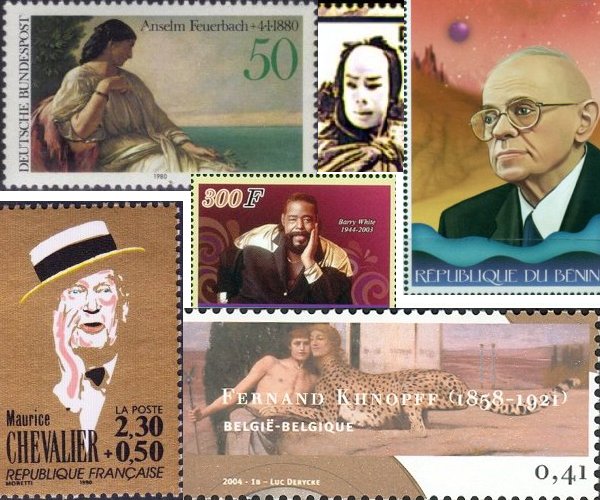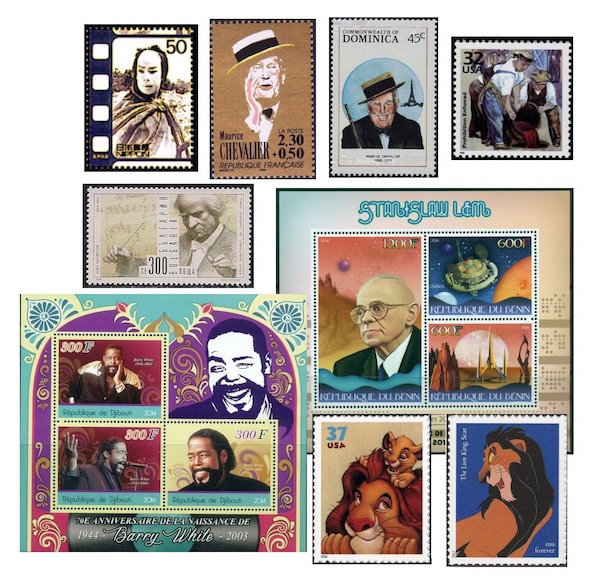The Arts on Stamps of the World — September 12
An Arts Fuse regular feature: the arts on stamps of the world.

By Doug Briscoe
Our first collage today is exclusively a painters’ club. September 12 is the birthday of German classicist Anselm Feuerbach (1829 – 4 January 1880). His father was an archaeologist and his grandfather a legal scholar. After study in Düsseldorf, Munich, Antwerp, and Paris, where he revealed his earliest masterpiece, Hafiz at the Fountain (1852), Feuerbach moved on to Italy. He and fellow painters Arnold Böcklin and Hans von Marées were so enamored of the Italian style that they came to be known as Deutschrömer (“German Romans”). It was in Rome that he met Anna Risi, affectionately called “Nanna”, who sat as his model for a number of paintings, including the one from 1860 seen on the Micronesian stamp. Feuerbach was also a friend of Brahms, who wrote his funeral song “Nänie”, Op. 82 (to a text of Schiller), in memory of the painter. One hundred years later, Germany issued a stamp in Feuerbach’s honor. It depicts a detail from his 1862 canvas Iphigenia. For comparison, here is the later 1871 version.
Dutch painter George Breitner (12 September 1857 – 5 June 1923) was also keenly interested in photography, in particular as it applied to capturing the rainy street scenes and harbor views he loved to paint, as example being Rokin with the Nieuwezijdskapel, Amsterdam (c1904). Born in Rotterdam, Breitner came to be associated with the Impressionist school and even worked for a time with Van Gogh sketching subjects in the working class sections of The Hague. Later, however, Breitner admitted he disliked the older man’s work. Breitner saw himself as a “people’s painter” and chose not to evolve along with newer artistic trends as the old century closed. I was not able to identify the painting shown on the Paraguayan stamp, but it bears a similarity to Girls in the Snow and Three Women Conversing in the Snow.
Well, we’ve had one classicist and one Impressionist, so on now to a symbolist, the Belgian Fernand Khnopff (12 September 1858 – 12 November 1921). He came of a family of legal practitioners and was expected to follow suit. He was strongly drawn to literature but took courses in painting. A fellow student, whom he disliked from the start, was James Ensor, though both were founding members of Le Groupe des XX. The critics condemned his first exhibition, but he was better received in England, where he made friends with the Pre-Raphaelites. He developed a great love for opera and theater and designed sets for one of Max Reinhardt’s Berlin productions as well as for the world première of Chausson’s opera Le Roi Arthus (1903) and several more. For a set of stamps issued by Belgium in 2004, the following pieces were selected: Portrait of Marguerite Khnopff (the artist’s sister, 1887), a sketch: The Abandoned City, and Khnopff’s most famous work, The Sphinx (or The Caress, 1896). I couldn’t identify the fourth piece, but it resembles both Mask with Black Curtain (pastels and charcoal on paper, 1909) and White Mask.
Next we move to film and an early Japanese actor of the silent era, Matsunosuke Onoe (September 12, 1875 – September 11, 1926). He was known by various stage names: Medama no Matchan (“Eyeballs” Matsu), Yukio Koki, Tamijaku Onoe, Tsunusaburo Onoe. His birth name was altogether different: Tsuruzo Nakamura. He started in kabuki drama, and in 1909 some of this action was captured on film. This led to a career in the new medium, and Onoe went on to take part in over a thousand film projects, most of them shorts. However, he also took the lead in Chushin-gura (1910), which is believed to be the world’s first feature film, though it has come down to us incomplete.

An actor much better known to us in the West was Maurice Chevalier (September 12, 1888 – January 1, 1972), who of course was also a singer and dancer. Born in Paris, he started in musicals in 1901. He was wounded in World War I and held prisoner of war for two years until released through the offices of the King of Spain, who was an admirer of Chevalier’s professional and romantic partner Mistinguett. He made some movies before going to Hollywood in 1928. Apparently he thickened his French accent when performing but spoke English without one off-screen. He enjoyed a comeback in the US beginning in the late fifties with appearances in films like Gigi.
Lithuanian-born artist Ben Shahn (September 12, 1898 – March 14, 1969) came to New York City with his family in 1906. His people had been Jewish craftsmen in Kaunas. Shahn was always keenly interested in social justice, and his first work to attract public attention was his series of paintings The Passion of Sacco and Vanzetti (1932). He followed that with another series on the labor leader Tom Mooney. Further social-documentary work was done for the Farm Security Administration in 1935. Shahn’s work was chosen for a stamp on the subject of Prohibition as part of the big millennium series looking back over the decades of the 20th century in America. Composer William Schuman wrote a memorial piece, “In Praise of Shahn”, after the artist’s death. Leonard Bernstein led the first performance and then recorded the work in the studio.
And this provides us with a nice segue into our next subject, the Bulgarian orchestra conductor Asen Naidenov, born on this date in Varna in 1899. After study in Vienna (with Josef Marx) and Leipzig, he made his conducting debut in 1925 in a performance of Mignon at the Sofia National Opera, of which two decades later he became chief conductor. (In the meantime he had undertaken further studies with Bruno Walter and Clemens Krauss.) Naidenov was at the helm of the Sofia Opera for over thirty years until 1979. He died two days before his 96th birthday, 10 September 1995. Apparently he made very few recordings (?) – in my collection I find just a single Rimsky-Korsakov aria on an old MHS LP licensed from Melodiya.

Probably the foremost Continental European writer of science fiction (so far) has been Stanisław Lem (12 September 1921 – 27 March 2006). Born in Lwów to a well-to-do secular Jewish family, Lem, a student of medicine, lived through the Nazi occupation on false papers. After the war, when Lwów was annexed by the Soviet Union, the family was resettled in Kraków. Soon Lem began to make his name as a writer, and his very first published novel was in the science fiction genre. He also wrote philosophy and satire. His novel Solaris has been made into three movies, the first in 1968 (directed by Boris Nirenburg), the Andrei Tarkovsky masterpiece of 1972, and the American remake from 2002, directed by Steven Soderbergh and starring George Clooney. About a dozen other film and television adaptations of his work have been made, but it seems the only one Lem himself approved of was Andrzej Wajda’s short television adaptation Przekładaniec (1968, translated into English as Layer Cake or Roly-Poly). The latest such film is an Israeli–Polish co-production from 2013, The Congress, after Lem’s novel The Futurological Congress (1971).
Barry White (September 12, 1944 – July 4, 2003) is one of the world’s best-selling artists, with sales of 100 million records, 106 gold albums, 41 of them platinum, and 20 gold and 10 platinum singles. White was born Barry Eugene Carter in Galveston, Texas, and grew up listening to his mother’s classical record collection. He recorded some singles in the early 1960s and became a songwriter, arranger, and producer. His first solo album came out in 1973. Overweight for many years, White died of kidney failure at the age of 58. He is remembered on a souvenir sheet from Djibouti.
German film score composer Hans Zimmer (born 12 September 1957) has written for many recent hit movies, including Gladiator, the Pirates of the Caribbean series, The Dark Knight Trilogy, Interstellar, and Dunkirk. He won an Academy Award for Best Original Score in 1995 for his music to The Lion King, and characters from that animated Disney feature have appeared on not one, but two US stamps. Mufasa and Simba on a 2004 stamp and Scar on one from this year (from a sheet of Disney villains just issued in July).
There is no stamp, though there ought to be, for the immortal H. L. Mencken (September 12, 1880 – January 29, 1956). And happy birthday to the splendid Sir Ian Holm (born 12 September 1931).
A graduate of the University of Massachusetts with a B.A. in English, Doug Briscoe worked in Boston classical music radio, at WCRB, WGBH, and WBUR, for about 25 years, beginning in 1977. He has the curious distinction of having succeeded Robert J. Lurtsema twice, first as host of WGBH’s weekday morning classical music program in 1993, then as host of the weekend program when Robert J.’s health failed in 2000. Doug also wrote liner notes for several of the late Gunther Schuller’s GM Recordings releases as well as program notes for the Boston Classical Orchestra. For the past few years he’s been posting a Facebook “blog” of classical music on stamps of the world, which has now been expanded to encompass all the arts for The Arts Fuse.
